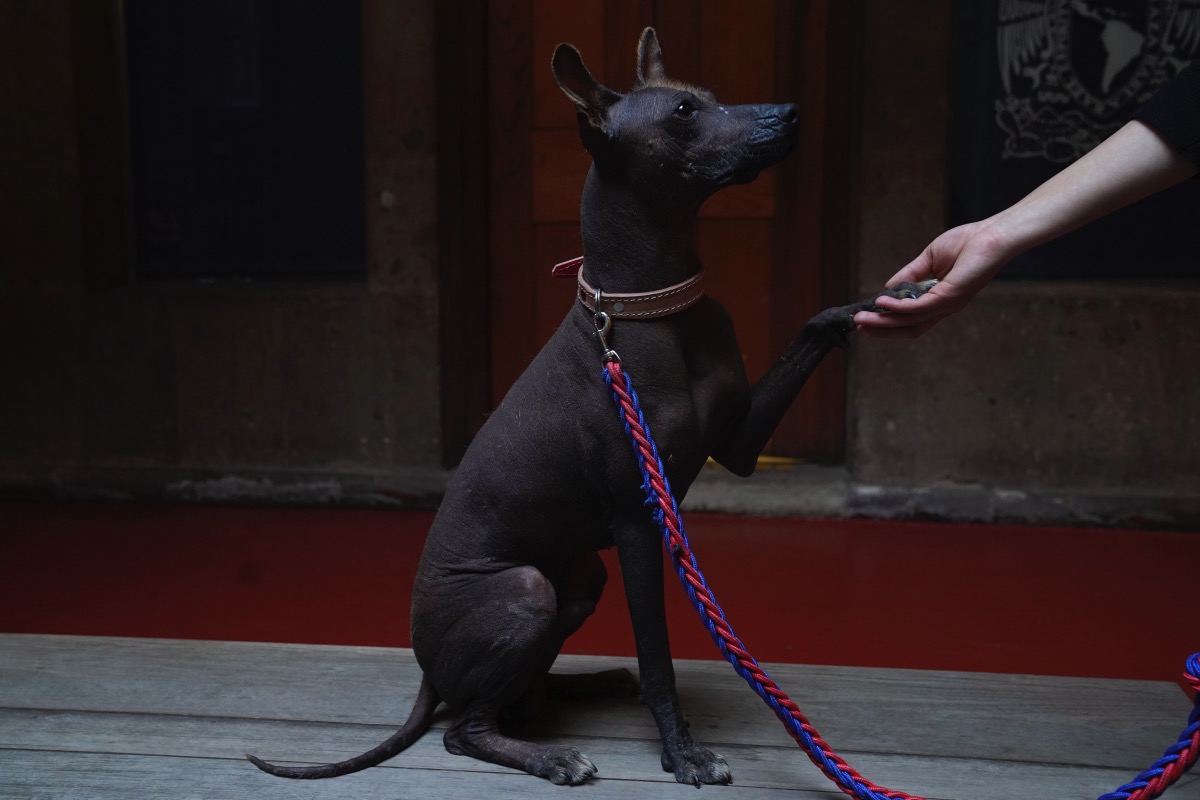

A woman holds the paw of her Xoloitzcuintle breed dog named Pilon, during a press conference about the Xoloitzcuintle in art, in Mexico City, Wednesday, January 25, 2023. (AP Photo/Marco Ugarte)
By MARÍA TERESA HERNÁNDEZ, Associated Press
MEXICO CITY (AP) — Mezcal is not your ordinary pet. Hundreds of years ago the Latin American Indigenous group, the Nahuas, believed that a hairless dog like him, the Xoloitzcuintle, was a sacred creature who could guide its deceased master through the underworld.
Dozens gathered on a recent day at Antiguo Colegio de San Ildefonso in Mexico City for a meet-and-greet with Mezcal and three more “Xolos,” as these slender dogs are locally known. The canines were at the art and culture museum as part of an effort to raise awareness about responsible adoption of Xolo puppies and promote the significance of the breed.
“Can I touch him?” asked a woman working security for the museum, as she nervously brought her hand closer to the dog’s head
“Absolutely! He loves to be petted,” said Mezcal’s owner, Nemiliz Gutiérrez, who leads a project with her sister promoting the breed to the public.
By reviewing ancient codex and records written after the conquest in 1521, experts have determined the religious relevance of the dogs among Mesoamerican civilizations. That fact isn’t lost on the sisters.
“We are privileged because we have among us some precious jewels of history that are living cultural heritage,” said Gutiérrez’s sister, Itzayani, who owns a playful Xolo named Pilón.
Experts found that the Nahuas believed these dogs represented the god, Xólotl, the twin brother of the deity Quetzalcóatl. While the latter personified life and light, the former was an effigy of the underworld and death. The Xolo, thought to be a creature capable of moving through the darkness, was conceived as a guide for their owner’s soul after dying, wrote historian Mercedes de la Garza in an article published by the National Autonomous University of Mexico.
Burial sites found by archaeologists in central Mexico show the remains of men and dogs lying side by side, which suggests that Xolos may have been sacrificed during their masters’ funeral rites. It was thought to be a way the living could ensure that when the soul of their loved ones reached the river of the underworld, it could reunite with its dog, mount on his back, and cross together.
In the Nahuatl language, “Xolo” means “monster,” and though some dislike the physical appearance of these dogs, many find them fascinating. Mezcal’s hairless skin is dark as a shadow. When touched, it feels soft and warm. His teeth are rarely visible, as Xolos don’t bark much. On the recent meet-and-greet, he posed for pictures like a movie star and leaned his head toward visitors wanting to pet him.
Like his predecessors, Mezcal never loses sight of Gutiérrez, who constantly pats her loving dog.
“Xolos are loyal by nature,” said Gutiérrez. “If one is adopted by a family, it will choose a member to stick with.”
The closeness between Xoloitzcuintles and their owners was also noted by the Nahuas, according to experts. To please the gods, some Xolos were sacrificed in order to spare their masters’ lives.
The dogs were killed in those ceremonies by extracting their hearts. This fact distinguished them from any other animal offered in sacrifice, wrote De la Garza.
The dogs also are a part of modern-day culture in Mexico and beyond. At least a couple of Xoloitzcuintles can be seen in Frida Kahlo’s paintings. A few more appear in portraits where the artist posed with her husband, Mexican muralist Diego Rivera. Their love for these pets was shared by friend and art collector Dolores Olmedo, whose home in Mexico City became a museum and until recently took care of a few Xolos that visitors could approach.
In 2016, the capital’s mayor gave the Xoloitzcuintle a cultural heritage designation, and a year later, a charming Xolo named Dante reached world fame after his appearance in the animated film Coco, which portrayed the adventures of a Mexican boy through the underworld.
Back in San Ildefonso, the Gutiérrez sisters hope more people will come to appreciate the breed’s significance and help it thrive. Once thought by experts to be headed toward extinction, Xolos can be spotted in upper-class Mexico City neighborhoods. Nemiliz Gutiérrez adopted Mezcal, but said some breeders sell the dogs for upwards of $3,500.
Not every Xolo is in demand though, especially the variety with fur.
“Almost nobody wants them,” said Gutiérrez, who works with her sister to find caring homes for all Xolos regardless of their coats. Through that process, they enjoy sharing information about the breed’s historic significance—when Xolos embodied an endless love believed to transcend death.


